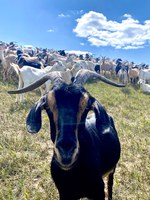Minnesota goat confirmed to have highly pathogenic avian influenza
(Click the image below to view a high-resolution image that can be downloaded)
A juvenile goat in Minnesota recently tested positive for highly pathogenic avian influenza (HPAI). While HPAI has been detected in predatory mammals that prey on infected birds, this is the first identified case of HPAI in domestic livestock in the U.S. The goat lived on the same premises where a poultry flock tested positive for HPAI in late February. The goat shared the same pasture and sole water source as the poultry flock.
HPAI is a known disease of wild and domestic poultry and waterfowl. There is limited information available about HPAI infection in ruminants, though in some species, animals with immature or compromised immune systems appear to be at greater risk of infection. Only young goats were afflicted in the Minnesota case, not mature goats. This case is being investigated by the Minnesota Board of Animal Health with the assistance of the U.S. Department of Agriculture.
“As we aim to protect livestock for our North Dakota producers, the risk of transmission increases during spring,” says Miranda Meehan, North Dakota State University Extension livestock environmental stewardship specialist.
“While we don’t envision this zoonotic transmission to be commonplace, good biosecurity protocols separating livestock from poultry/waterfowl is a good production practice to reduce the potential spread of HPAI to our small ruminants during the spring migration of wild birds,” says Travis Hoffman, NDSU Extension sheep specialist.
“H5N1 HPAI has been detected in wild birds throughout all U.S. migratory flyways, says Dr. Gerald Stokka, NDSU Extension veterinarian and livestock stewardship specialist. “Wild birds can be infected without showing symptoms of the infection. While waterfowl are the primary carriers, positive cases are being documented in predatory birds and mammals, and now domestic goats.”
NDSU Extension experts support the biosecurity practices released by University of Minnesota Extension that can reduce the potential for domestic animals to contract HPAI. Recommended practices include:
- Do not allow poultry and livestock species access to ponds, wetlands and other stagnant water sources that are frequented by wild waterfowl such as ducks, geese or swans.
- Watch poultry and livestock for signs of illness, including reduced appetite, fever, inability to stand, depression, nasal discharge, diarrhea, coughing and change in behavior.
- Consider housing poultry separately from other livestock species and minimize poultry access to pasture areas that are grazed by other livestock species.
- Do not allow poultry, waterfowl and wildlife to share water sources and feedstuffs with other livestock species.
Protocols for protecting livestock include:
- In the Minnesota goat case, infected goats shared the same water source as infected poultry. Limiting livestock exposure to potentially inflicted-HPAI poultry is the first action of defense.
- Current influenza vaccines used in horses are not effective against HPAI. Always consult your veterinarian before administering vaccinations.
- Many cattle are vaccinated against Parainfluenza-3 (PI-3), a virus that can cause respiratory issues. Parainfluenza viruses are in a different family from influenza viruses and the PI-3 vaccine does not provide protection against influenza.
- If you have an unexplained death in one of your animals, consult with your farm veterinarian, contact the North Dakota Board of Animal Health.
“There is no evidence that anyone has contracted the virus from eating a fully cooked bird, either domestic or wild,” says Julie Garden-Robinson, NDSU Extension food and nutrition specialist and professor of health, nutrition and exercise sciences. “It is always a safe practice to fully cook wild game to 165 degrees Fahrenheit, regardless of whether there is a threat of HPAI.”
NDSU Extension HPAI resources are available at ndsu.ag/hpai. UMN Extension HPAI resources are available at z.umn.edu/HPAIgoat.
Avian influenza surveillance and testing in wild birds is being done by the USDA’s Animal and Plant Health Inspection Service (APHIS) and the North Dakota Department of Game and Fish. To learn more about HPAI cases in birds and mammals, please visit the USDA’s APHIS website. Report sick and dead wildlife at https://gf.nd.gov/wildlife/diseases/mortality-report. Direct wild bird avian influenza questions to 701-204-2161.
NDSU Agriculture Communication – March 21, 2024
Contact: Miranda Meehan, 701-231-7683, miranda.meehan@ndsu.edu
Contact: Travis Hoffman, 701-231-2222, travis.w.hoffman@ndsu.edu
Contact: Gerald Stokka, 701-231-5082, gerald.stokka@ndsu.edu
Contact: Julie Garden-Robinson, 701-231-7187, julie.garden-robinson@ndsu.edu
Contact: Heidi Pecoraro, NDSU Veterinary Diagnostic Lab, 701-231-8307, heidi.pecoraro@ndsu.edu
Contact: North Dakota State Veterinarian’s Office, 701-328-2655, doa-bah@nd.gov
Editor: Elizabeth Cronin, 701-231-7006, elizabeth.cronin@ndsu.edu
Acknowledgements: University of Minnesota Extension Team: Abby Schuft, PhD, UMN Extension; Carol Cardona, DVM, PhD, UMN CVM; Joe Armstrong, DVM, UMN Extension; Anna Firshman, DVM, UMN CVM; and Krishona Martinson, PhD, UMN Extension


